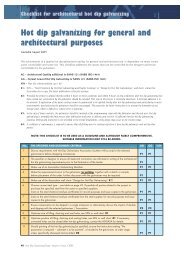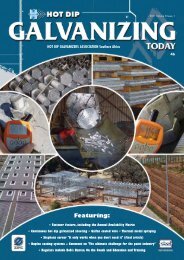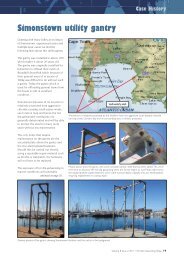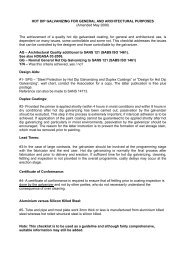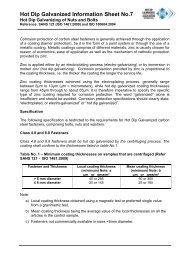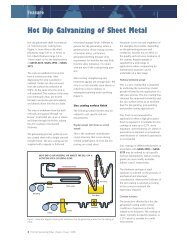Featuring: - hdgasa
Featuring: - hdgasa
Featuring: - hdgasa
- No tags were found...
You also want an ePaper? Increase the reach of your titles
YUMPU automatically turns print PDFs into web optimized ePapers that Google loves.
Bob’s BanterLike Michelangelo, we should be smart when it comes to arguingMichelangelo was once asked by the Mayor of Florence towork on a huge block of fine marble, which had beenpreviously damaged by an unskilful sculptor. No othersculptor, including Leonardo da Vinci, would touch themarble, saying it was totally ruined. Like the genius he was,Michelangelo knew he could adapt the pose of the humanfigure he would create, using a bending-over posture, sothat the marble could still be used to great effect.Nearing completion, the Mayor visited Michelangelo toview the piece of art. While agreeing that it was indeed agreat work, he had some misgivings about it. Fancyinghimself a bit of an art connoisseur, he believed the nosewas too big and it should be made smaller. Michelangelorealised that the Mayor was viewing the sculpture from awrong perspective and from this angle was not seeing theface properly.Without hesitating, Michelangelo invited the Mayor toaccompany him up the scaffolding around the sculpture.Reaching the nose, he began gently tapping his chisel onthe nose, at the same time releasing some marble dust thathe had concealed in his hand. He did nothing to the nosebut gave the appearance of making it smaller. The Mayorwas impressed: “that looks so much better, I knew I wasright, it has come alive”, he stated. “You’re a great sculptorMichelangelo.”Michelangelo was a supreme diplomat. He knew changingthe nose would ruin the sculpture. But, he did not want toupset his patron, who prided himself on his artisticjudgement. He knew too that if he upset the Mayor hewould not receive any further commissions. By taking himup the scaffold he changed the Mayor’s viewing angle and,without telling him, did not make him aware of hismisperception when viewing sculptures. By not arguing,Michelangelo was able to retain his work for posterity andat the same time enhance his standing with an importantclient by making him think it was his idea. For after all, whoelse was able to improve the work of Michelangelo?We all love to argue; politics, religion, sport, cars, marriage,crime, economics, etc.: there’s not much we don’t argueabout at dinner parties, in the pub, at the office, at home,wherever. Whenever there are more than two people, weargue and even argue with ourselves. In general, anargument is ‘a discussion involving conflicting points ofview’ (Wikipedia), which on its own is part of our life: itseems we are born to argue. Often, however, it is not theargument as much as the language we use, the impact ofthe language on the arguers and that we seldom seem toresolve our arguments. My point of view is mine, yours isyours and you and I will stick to our opinions come whatmay. Even if we ‘agree to disagree’, this just means for now;we will start the argument when we meet again and, just forspice (or perhaps spite) usually add some extra opinions tothe argument pot.We must, however, not confuse the form of arguing we aretalking about with what we can perhaps call, ‘philosophicalargument’, the science and concept of which emanatedfrom the ancient Greek philosophers, like Socrates. Here,arguments are used, with or without empirical evidence orgeneral observations, to establish a convincing conclusionabout various issues. In this vein, an argument has aninternal structure, comprising of a set of agreedassumptions or premises, a method of reasoning ordeduction and a conclusion or point. An argument musthave at least one premise and one conclusion. Regrettably,this is not how we tend to argue: we don’t agree on thebasis of our argument- we just have our firm beliefs, wedon’t normally reason or deduce-we just state what wethink is true and we seldom get to a conclusion.Like Michelangelo, we should be smart about arguing. Weshould recognise and acknowledge the party(ies) withwhom we are arguing, understand what effect our arguingwill have on ourselves and on others and be careful of thelanguage we use. Sure, arguing as we know it is part ofsocialising and it’s fun and often does no harm. But thereare many other occasions where perhaps we should bemore philosophical. This may not sound like too much funbut it can be a valuable way of acquiring and sharingknowledge and will not have any harmful effects.The Association wishes to thank Bob Andrew who is a consulting valueengineer and honourary member of the Association for his article. He canbe contacted on anneve@iafrica.com or boband@mweb.co.za22 Hot Dip Galvanizing Today Volume 5 Issue 4 2008



